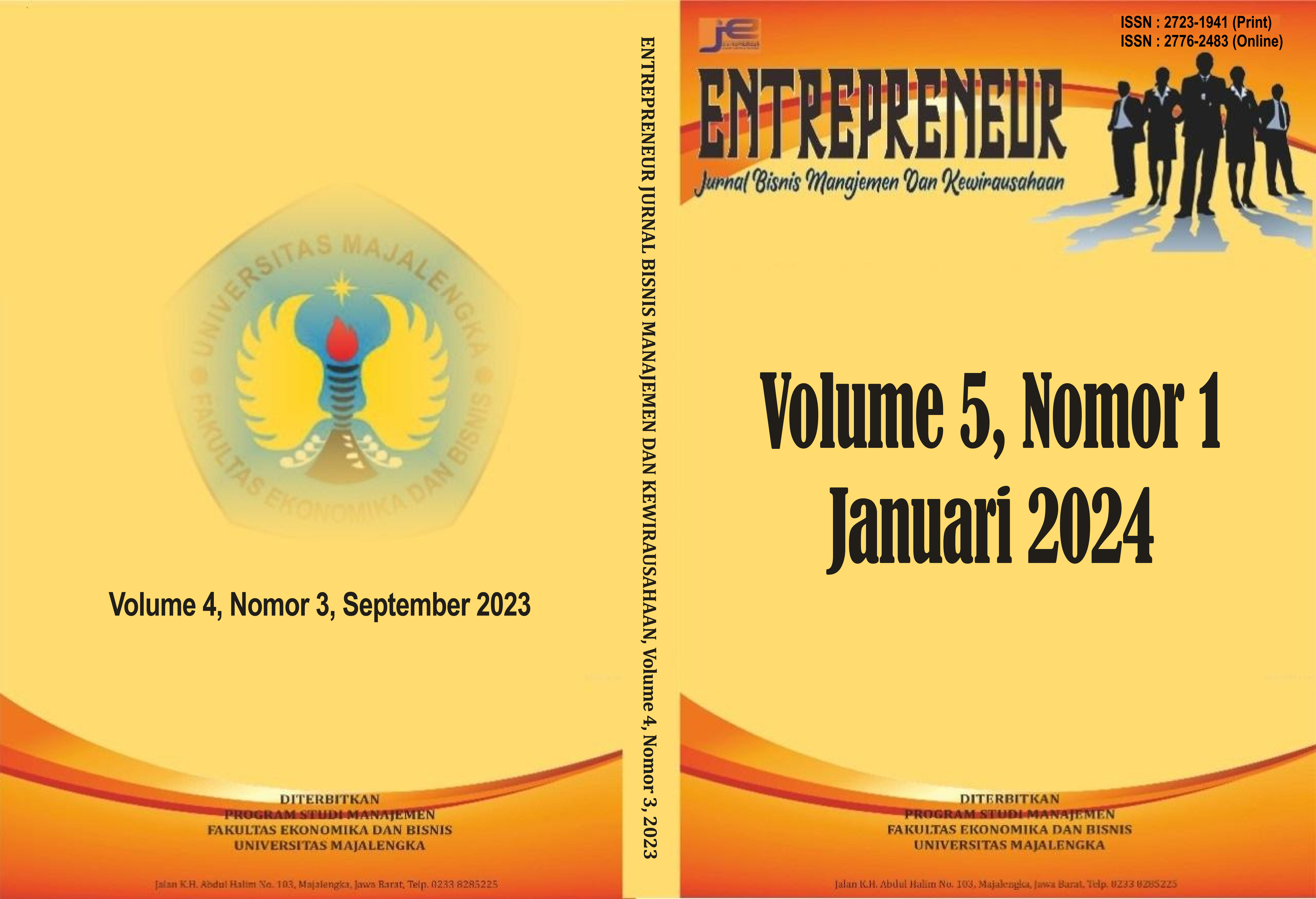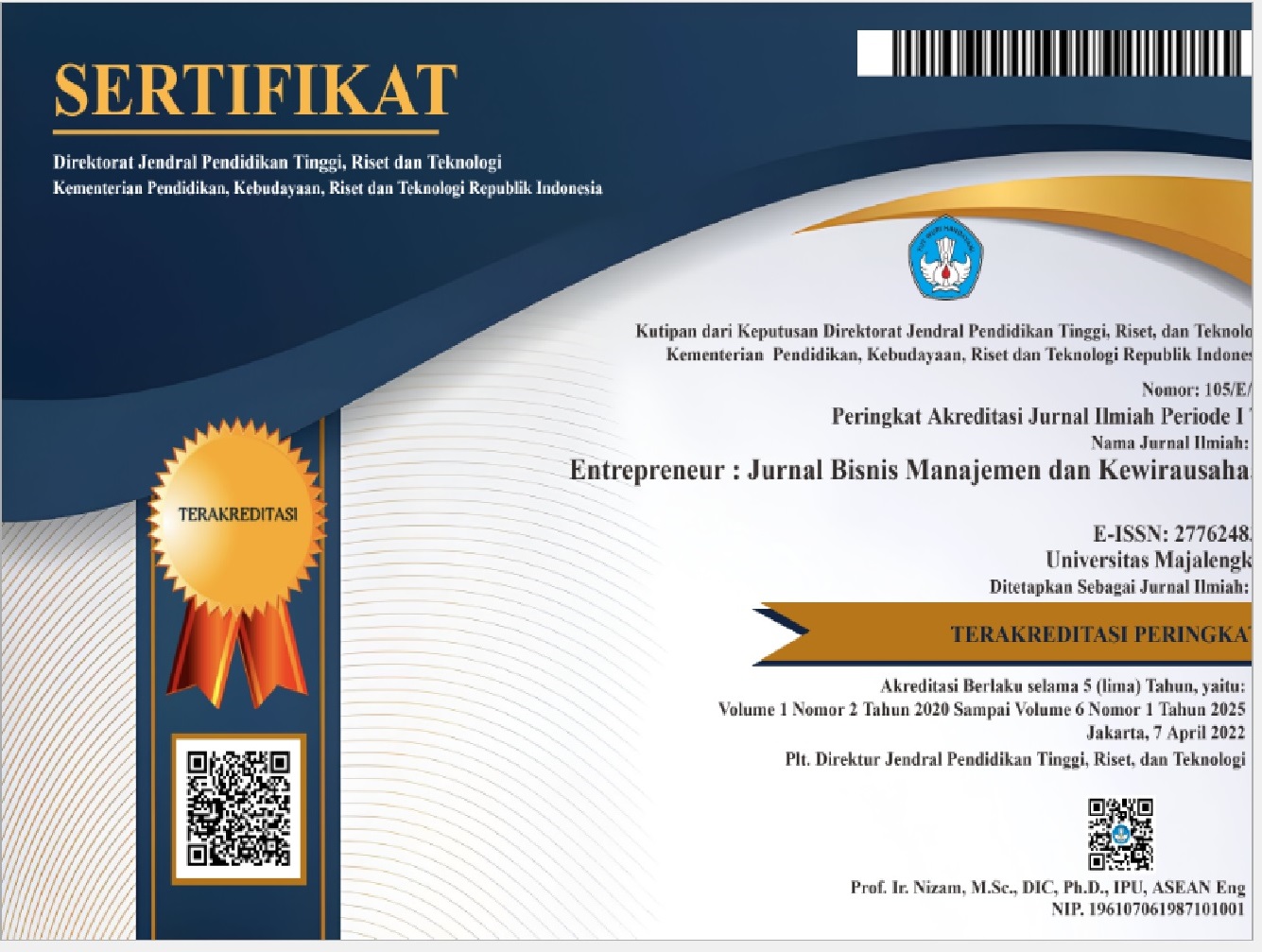Sistem Pengendalian Internal Piutang Dalam Meminimalkan Piutang Tak Tertagih Pada PT PCS
DOI:
https://doi.org/10.31949/entrepreneur.v5i1.7500Abstract
The payment system used by PT PCS can generally be done in cash or credit, the increase in credit sales is an inhibiting factor in increasing company profits, because many customers are late in paying receivables until they exceed the payment due date. This problem occurs because there is no effective accounts receivable control system at PT PCS. This study aims to analyze the accounts receivable internal control system in minimizing bad debts at PT PCS. The method used is descriptive qualitative method to describe the representation of internal control and bad debts at PT PCS through interviews and observations. The results obtained by researchers are, PT PCS has not implemented a good accounts receivable internal control system, as evidenced by the large number of PT PCS employees who collect accounts receivable without paying attention to the terms and conditions in accordance with the Standard Operating Procedure for credit sales applicable at PT PCS, and based on the calculation of the accounts receivable collection ratio, proving that uncollectible accounts at PT PCS from 2018 to 2022 have increased significantly.
Keywords:
Internal Control, nternal Control of Receivables, Bad DebtDownloads
References
Rahmawati. (2021). Teori Akuntansi Keuangan Dasar (Pertama). Graha Ilmu.
Abdillah, & Basri. (t.t.-a). Analisis Piutang Tak Tertagih Berdasarkan Umur Piutang Pada Pt. Graha Arta Kaltim Sentosa Samarinda.
Amalia, N., & Handayani, A. (2023). Receivable Internal Control Analysis To Minimize Risk Uncollectible Accounts At Pt X. Jurnal Akuntansi, 8(1).
Asteria. (t.t.-b). Analisis Piutang Tak Tertagih pada PT Astra International Tbk. VOL.7, NO.2, NOVEMBER 2018, 184–190.
Dewi Handika Yani. (2019). Analisis Pengendalian Intern Piutang dalam Meminimalisasi Piutang Tak Tertagih pada PT. Jalur Nugraha Ekakurir (JNE) cabang Medan. Civitas: Jurnal Studi Manajemen, Vol. 1, No. 1, hlm. 20–24, Juli 2019, 20–24.
dkk, R. (2020). Analisis Pengendalian Piutang Tak Tertagih Berdasarkan Umur Piutang Terhadap Kinerja Laporan Keuangan Pada Pt. Bestindo Persada. MEASUREMENT JURNAL AKUNTANSI, Vol 14, No 2 (2020), 35–44.
Dwiasnati, S., & Hidayat, R. R. (2022). Penerapan Manajemen Risiko Menggunakan COSO: Enterprise Risk Management Framework Integrated Pada PT ALPHANET. Jurnal Tata Kelola dan Kerangka Kerja Teknologi Informasi, 8(2), 66–72. https://doi.org/10.34010/jtk3ti.v8i2.7845
Eka Putri, D. K., & Pravitasari, D. (2023). Penerapan Sistem Informasi Akuntansi Pengelolaan Kas sebagai Upaya Pengendalian Internal di Kantor BAZNAS Tulungagung. Jurnal Ekonomi Bisnis, Manajemen dan Akuntansi (JEBMA), 3(3), 672–682. https://doi.org/10.47709/jebma.v3i3.2951
Habibie, N. (2013). Analisis Pengendalian Intern Piutang Usaha Pada Pt Adira Finance Cabang Manado.
Herawati, T. D. (t.t.). Analisis Manajemen Piutang (Studi Kasus Pada Pt Baltec Exhaust Dan Inlet System Indonesia).
Hery. (2015a). Analisis Laporan Keuangan Manajemen (Pertama). PT Grasindo.
Istanti, E. (t.t.). Evaluasi Prosedur Pengendalian Intern Atas Piutang Usaha Pada Pt Sps (Depo Gedangan).
Januardo. (2016a). Implementasi Penyelesaian Piutang (Edisi Pertama). Raja Grafindo Persada.
Krismiaji. (2010). Sistem Informasi Akuntansi (Pertama). UPP-STIM YKPN.
Lubis, P. K. D., & Barus, A. U. (t.t.). Analisis Sistem Pengendalian Intern Kas Pada PT. Ira Widya Utama Medan.
Naibaho, E., Supitriyani, S., Manurung, S., & Ervina, N. (2019). Pengendalian Intern Piutang Untuk Meminimalkan Piutang Tak Tertagih Kp-Ri Jaya Dinas P Dan K Kabupaten Simalungun. FINANCIAL: JURNAL AKUNTANSI, 5(2), 11–21. https://doi.org/10.37403/financial.v5i2.106.
Mulyadi. (2012). Sistem Perencanaan dan Pengendalian Manajemen (Pertama). Salemba Empat.
Mulyadi. (2016b). Metode Akuntansi Biaya (Edisi Pertama). Alfabeta Salemba Empat.
Rahmawati. (2021). Teori Akuntansi Keuangan Dasar (Pertama). Graha Ilmu.
Reviandani, W. (2021). Analisis Laporan Keuangan (Edisi Pertama). SidoarjoIndomedia Pustaka.
Reviandani, W., & Pristyadi. (2019). Pengantar Akutansi. Indomedia Pustaka.
Hery. (2015a). Analisis Laporan Keuangan Manajemen (Pertama). PT Grasindo.
Istanti, E. (t.t.). Evaluasi Prosedur Pengendalian Intern Atas Piutang Usaha Pada Pt Sps (Depo Gedangan).
Krismiaji. (2010). Sistem Informasi Akuntansi

Published
How to Cite
Issue
Section
License
Copyright (c) 2024 Dewi Safitri Dewi, Wasti Reviandani

This work is licensed under a Creative Commons Attribution-ShareAlike 4.0 International License.
COPYRIGHT NOTICE
An author who publishes in the Entrepreneur: Jurnal Bisnis Manajemen dan Kewirausahaan agrees to the following terms:
1. Author retains the copyright and grants the journal the right of first publication of the work simultaneously licensed under the Creative Commons Attribution-ShareAlike 4.0 License that allows others to share the work with an acknowledgment of the work's authorship and initial publication in this journal
2. The author is able to enter into separate, additional contractual arrangements for the non-exclusive distribution of the journal's published version of the work (e.g., post it to an institutional repository or publish it in a book) with the acknowledgment of its initial publication in this journal.
3. The author is permitted and encouraged to post his/her work online (e.g., in institutional repositories or on their website) prior to and during the submission process, as it can lead to productive exchanges, as well as earlier and greater citation of the published work







